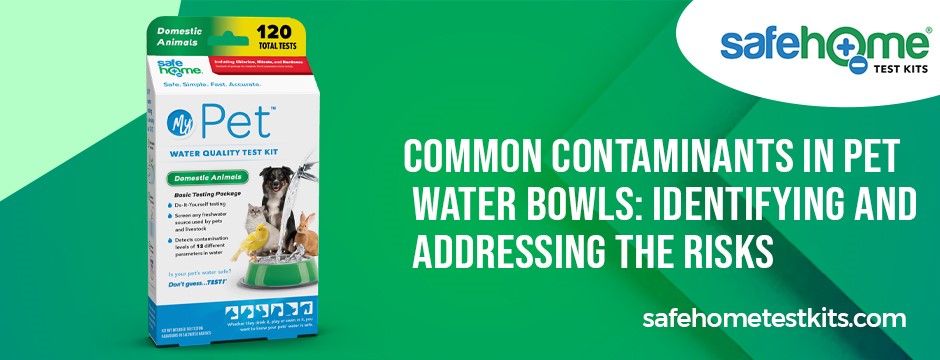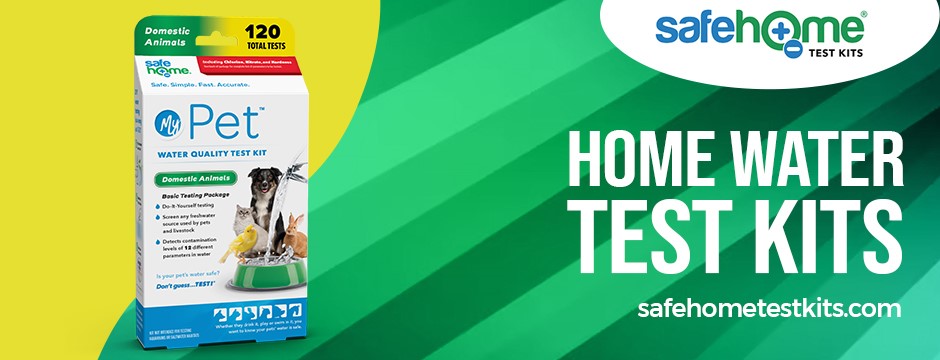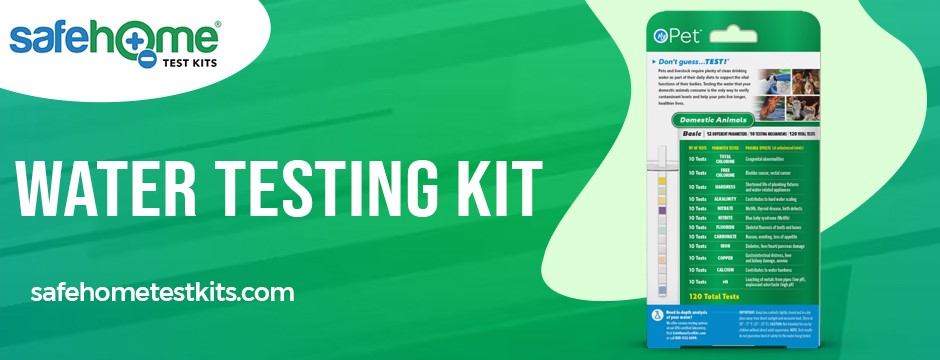Common Contaminants in Pet Water Bowls: Identifying and Addressing the Risks

When it comes to our beloved pets, their health and well-being are of utmost importance. One often overlooked aspect of pet care is ensuring their drinking water is clean and contaminant-free. Like us, pets require clean water to thrive, and they can be adversely affected by common contaminants in their water bowls.
In this comprehensive guide, we’ll delve into pet water bowl contamination. We’ll explore the common contaminants that can risk your pet’s health and discuss how to identify and address these issues using a water test kit for pets. Whether you have a cat, dog, rabbit, or furry friend, this guide will help ensure their water is safe, clean, and conducive to a healthy life.
Common Contaminants in Pet Water Bowls
Before we dive into the nitty-gritty of identifying and addressing contamination, let’s familiarize ourselves with the common culprits that can compromise your pet’s water quality.
Bacteria
Bacteria are microscopic organisms that can quickly multiply in stagnant water. Some common harmful bacteria found in pet water bowls include:
- E. coli can cause gastrointestinal distress and severe illness in humans and pets.
- Salmonella: Pets can contract Salmonella from contaminated water, leading to digestive problems and other health issues.
- Campylobacter: This bacterium can cause diarrhea and abdominal pain in pets.
Algae
Algae are simple, plant-like organisms that can thrive in water when conditions are favorable. While not all algae are harmful, some species can produce toxins that pose risks to pets, such as:
- Blue-Green Algae: This type of algae can produce harmful toxins that, when ingested, lead to severe illness or even death in pets.
Mold and Mildew
Mold and mildew thrive in damp and dark environments. When they develop in a pet water bowl, they can lead to health problems like:
- Allergic Reactions: Pets may develop allergies to mold and mildew, resulting in skin irritation, itching, or even respiratory issues.
Biofilm
Biofilm is a slimy layer of bacteria that can develop on the surface of water bowls. It can be harmful to pets in the following ways:
- Digestive Issues: Pets may ingest biofilm, leading to digestive problems and potential illness.
Now that we know the common contaminants, let’s explore how to identify and address these issues.
Identifying Contamination in Your Pet's Water Bowl
Visual Inspection
Visual inspection is one of the easiest ways to identify contamination in your pet’s water bowl. Look out for:
- Visible Algae: Algae can give the water a greenish tint or create a slimy film on the bowl’s surface.
- Mold or Mildew: These fungi often appear as black or green spots or a powdery substance on the bowl.
Odor
A strong, unpleasant odor emanating from your pet’s water bowl can indicate contamination. Investigate further if you notice a foul smell.
Behavioral Changes in Pets
Pay attention to your pet’s behavior when it comes to water consumption. If they seem hesitant to drink, avoid the water bowl or exhibit signs of illness, contamination may be a factor.
Health Risks for Pets
Contaminated water can pose various health risks to pets, including:
Digestive Problems
Bacterial contamination, such as E. coli or Salmonella, can lead to digestive distress, including diarrhea and vomiting.
Skin and Fur Issues
Allergic reactions to mold and mildew can result in skin irritations, itching, or rashes, causing discomfort for your pet.
Respiratory Problems
Inhaling mold spores or biofilm particles can lead to respiratory issues, especially in pets with pre-existing conditions.
Long-term Health Concerns
Consistent exposure to contaminated water can lead to chronic health issues in pets, potentially affecting their overall quality of life.
Now that we understand the risks associated with contaminated water let’s move on to the steps you can take to prevent contamination in your pet’s water bowl.
Preventing Contaminants in Pet Water Bowls
Regular Cleaning
Frequent cleaning of your pet’s water bowl is crucial in preventing contamination. Follow these guidelines:
- Cleaning Frequency: Clean your pet’s water bowl daily to prevent the buildup of bacteria, algae, and biofilm.
- Proper Cleaning Techniques: Use pet-safe cleaning agents or vinegar and water. Avoid harsh chemicals that can harm your pet.
Use of Pet-Friendly Cleaning Products
Ensure that the cleaning products you use in and around your pet’s water bowl are safe and non-toxic. Avoid products that contain harmful chemicals.
Filtered Water Bowls
Consider investing in a filtered water bowl. These bowls have filtration systems to help remove contaminants, providing your pet with cleaner water.
Proper Bowl Material
Choose water bowls from safe materials like stainless steel, glass, or BPA-free plastic. Avoid potentially harmful materials that can leach into the water.
Location and Sunlight Exposure
Place your pet’s water bowl in a location that receives adequate sunlight. Sunlight can help prevent algae growth. Also, choose a spot away from potential contaminants, such as pesticides or chemicals.

Testing Pet Water for Contaminants
To ensure your pet’s water is safe, regular testing is essential. You can do this with the help of pet water quality test kits.
Water Testing Kits
Home water test kits are readily available and easy to use. They allow you to check your pet’s water for contaminants. Follow these steps:
- Select a Testing Kit: Choose a kit suitable for your needs, ensuring it checks for common contaminants.
- Collect a Sample: Follow the kit’s instructions to collect a water sample from your pet’s bowl.
- Conduct the Test: Use the kit to analyze the water sample as instructed.
- Interpret the Results: Review the results to identify any contamination issues.
Frequency of Testing
Establish a testing schedule based on factors like your pet’s health, the local environment, and any changes in the water source. Regular testing ensures you catch and address issues promptly.
Addressing Contamination: Remediation and Treatment
If you suspect or detect contamination in your pet’s water, follow these steps:
Immediate Action Steps
- Cease Use: Discontinue the use of the contaminated water immediately.
- Provide Clean Water: Offer your pet access to clean, uncontaminated water.
- Consult a Veterinarian: If your pet shows signs of illness, seek prompt veterinary care.
Cleaning and Disinfection
- Deep Cleaning Procedures: Thoroughly clean and disinfect the water bowl to remove all traces of contamination.
- Safe Disinfection Methods: Use pet-safe disinfectants, vinegar, and water for effective and safe disinfection.
Seeking Veterinary Advice
Consult a veterinarian if your pet displays any signs of illness due to water contamination. They can diagnose and treat your pet’s condition and provide guidance on ensuring their future water supply is safe.
Educating Pet Owners
As responsible pet owners, raising awareness about the importance of clean water bowls is crucial. Share your knowledge with fellow pet owners to ensure the well-being of all furry companions.

Pet Water Quality Test Kits: Ensuring Safe Water
My Pet Domestic Animals Water Quality Test Kit – BASIC
- This DIY water testing kit is ideal for routine maintenance.
- It allows you to screen for unsafe contamination levels.
- Test results are instant, enabling prompt action if needed.
Deluxe DIY Testing Package
- Provides approximate values for 12 parameters, offering peace of mind about your pet’s water quality.
- Don’t guess; test to ensure your pet’s water is safe.
Importance of Testing for Pet Water
Pets and livestock rely on clean drinking water for vital bodily functions. High levels of contaminants can harm their organs. Testing is the only way to detect unsafe contamination, so provide them with continuous access to clean water for a healthier, happier life.
Safe Home® Test Kits
Designed for various freshwater sources like well water, rainwater, pond water, municipal water, filtered water, spring water, lake water, and river water, Safe Home® water test kits ensure that your pet’s water is consistently safe and clean.
Conclusion
Ensuring clean and safe water for your pets is a responsibility every pet owner should take seriously. By understanding the risks associated with contaminated water, regularly testing, and following proper preventive measures, you can provide your furry companions with the best possible drinking water. Remember, a healthy pet starts with clean and safe hydration.


